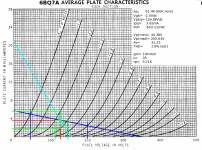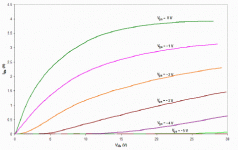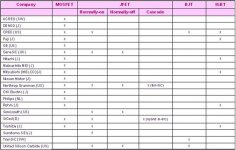Guys,
I'm definitely on unfamiliar ground here. So, please take it easy on me. Whatever expertise I have lies in the "hollow state" arena.
Perhaps these SiC power JFETs could be mated to Plitron's PAT 4152-00 (sic) SS O/P trafo. Source follower topology and no NFB, at all, would be used around the O/P stage.
Miles Prower has already pointed out the need to use a tube like rail voltage with these "puppies". Tubed small signal amplification can be very linear, without the application of loop NFB. Hybrid amp, anybody?
I'm definitely on unfamiliar ground here. So, please take it easy on me. Whatever expertise I have lies in the "hollow state" arena.
Perhaps these SiC power JFETs could be mated to Plitron's PAT 4152-00 (sic) SS O/P trafo. Source follower topology and no NFB, at all, would be used around the O/P stage.
Miles Prower has already pointed out the need to use a tube like rail voltage with these "puppies". Tubed small signal amplification can be very linear, without the application of loop NFB. Hybrid amp, anybody?
Last edited:
Hybrid amp, anybody?
Definitely a possibility. I considered the alternative of using an LTP implemented with cascoded 6BQ7s. I've already used this topology for the front end of another, hollow state, project. Works great.
Attachments
To add some fuel to the fire, I just read an article about Microsemi's new series of SiC SITs. They are rated for 1200V and touted as the next best thing for radar applications. I haven't had the time to seek out any more information, but the more avid types here might feel compelled to give it a go....
Well, Ilooked areound, and the devices are rated for 250V VDS, 1250W peak or something like that. The data sheets are pretty spotty as of yet and aimed at RF-heads, which I'm not...
Where did you find these? I found one article with characteristics, and day-um these look good.
Attachments
Below the datasheet for these microsemi SIT:
http://www.microsemi.com/datasheets/0150SC-1250M%20Rev%20B.pdf
http://www.microsemi.com/datasheets/0405SC-1000M%20Rev%20C.pdf
Francesco
http://www.microsemi.com/datasheets/0150SC-1250M%20Rev%20B.pdf
http://www.microsemi.com/datasheets/0405SC-1000M%20Rev%20C.pdf
Francesco
Last edited:
Assuming they're even available to the general public, I would expect the Microsemi parts to be as expensive as those from Semisouth. RF is a pricey niche business, especially high power. To add more confusion, a Scandinavian firm is offering SiC bipolar transistors that are rated for high voltage and high temp, and have much smaller storage times than their silicon little brothers. Wait 'till the GaN parts hit the street....
Some TranSiC data is here:
Silicon Carbide Power Transistors Offer Improved Performance
Silicon Carbide Power Transistors Offer Improved Performance
Here is the article from 2007 about SiC market players:
I-Micronews - POWER ELECTRONICS : Status of the SiC power devices market: If only we had a sw...
and current products from UnitedSiC:
United Silicon Carbide, Inc. - JFET
and this year news on SemiSouth:
http://compoundsemiconductor.net/csc/features-details.php?id=19733510
I-Micronews - POWER ELECTRONICS : Status of the SiC power devices market: If only we had a sw...
and current products from UnitedSiC:
United Silicon Carbide, Inc. - JFET
and this year news on SemiSouth:
http://compoundsemiconductor.net/csc/features-details.php?id=19733510
Attachments
Last edited:
SemiSouth JFETs are now available at Farnell...
SEMISOUTH|SJEP120R100|JFET, SIC, N-OFF, 1200V, 17A, | Farnell United Kingdom
SEMISOUTH|SJEP120R100|JFET, SIC, N-OFF, 1200V, 17A, | Farnell United Kingdom
It's nice to know that Kneeeejerk/Farnell have the Semisouth parts, though the price is dear. Has anyone tried the equally expensive Cree SiC parts (stocked by Digi-Key)? I haven't looked too closely, as the price tag is somewhat scary, but I think these are enhancement-mode mosfets of the more usual sort, though maybe posessed of some magic for those brave enough to bias them into linear operation (?).
A question to the gathered intellects here.
I am working on a research program (ahem) for which I need a fast, rugged switch to disconnect or connect amplifier loads to ground. FETs suggest themselves but they normally have an anti-parallel build-in diode, so for an AC switch the usual way is to use two FETs in series, in opposite direction.
These new SITs apparently don't have the anti-parallel diode, are fast and rugged so seem a perfect fit for me. Only, I am not sure if I can use them as AC switches - bidirectionally. I think I can, because off, they're off, and when on, they are a very low R. But I would like it confirmed before raising my mortgage again . Any issues I missed?
. Any issues I missed?
jan didden
I am working on a research program (ahem) for which I need a fast, rugged switch to disconnect or connect amplifier loads to ground. FETs suggest themselves but they normally have an anti-parallel build-in diode, so for an AC switch the usual way is to use two FETs in series, in opposite direction.
These new SITs apparently don't have the anti-parallel diode, are fast and rugged so seem a perfect fit for me. Only, I am not sure if I can use them as AC switches - bidirectionally. I think I can, because off, they're off, and when on, they are a very low R. But I would like it confirmed before raising my mortgage again
jan didden
Hi Jan,
That's an interesting application. I've used small signal JFETs in the past for solid state 50 Ohms input termination switching. Don't forget a JFET has an intrinsic gate to channel diode which a MOSFET is missing fortunately.
Duncan.
Duncan,
Does that account for the very low impedance specified as the gate input impedance? So, are these really FETs with an essential capacitive input Z, or more like a B-E junction. I'm confused now.
BTW, if the Vds is inverted while they are in the off state, is there any leakage current you think?
jan didden
Hello Jan,
I'm affraid both... I took a brief look on this application note:
http://www.semisouth.com/application/AN-SS1rev1.pdf
Please have a look on the equivalent circuit shown on page 2.
What confused me too is the normally-off variant of this JFET. This requires forward biasing of the gate to channel junction, represented as two diodes in this diagram, to obtain a conducting channel.
Do you mean channel leakage or gate leakage?
Duncan.
Duncan,
So, are these really FETs with an essential capacitive input Z, or more like a B-E junction. I'm confused now.
I'm affraid both... I took a brief look on this application note:
http://www.semisouth.com/application/AN-SS1rev1.pdf
Please have a look on the equivalent circuit shown on page 2.
What confused me too is the normally-off variant of this JFET. This requires forward biasing of the gate to channel junction, represented as two diodes in this diagram, to obtain a conducting channel.
BTW, if the Vds is inverted while they are in the off state, is there any leakage current you think?
jan didden
Do you mean channel leakage or gate leakage?
Duncan.
Hello Jan,
I'm affraid both... I took a brief look on this application note:
http://www.semisouth.com/application/AN-SS1rev1.pdf
Please have a look on the equivalent circuit shown on page 2.
What confused me too is the normally-off variant of this JFET. This requires forward biasing of the gate to channel junction, represented as two diodes in this diagram, to obtain a conducting channel.
Do you mean channel leakage or gate leakage?
Duncan.
Hi Duncan,
Yes, thanks for that link. Gate drive is clear to me now.
As for the use as an AC switch, I was wondering what the channel leakage would be when reverse-biased? Can these devices withstand reverse bias? A 'normal' FET with an antiparallel diode can never be reverse biased since the diode would conduct, but that's not the case here.
jan didden
- Status
- This old topic is closed. If you want to reopen this topic, contact a moderator using the "Report Post" button.
- Home
- Amplifiers
- Solid State
- SemiSouth SiC Power JFETs


